performance in brazil's mega-metropolis
carlos gomes: contemporary performance, sao paulo
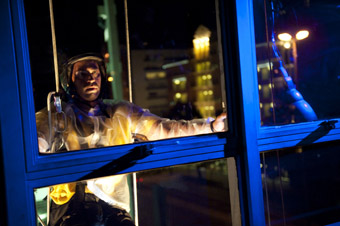
Marcel Costa Kastelo, Vertigem
photo Nelson Kao
Marcel Costa Kastelo, Vertigem
A TYPICAL DAY IN SAO PAULO, BRAZIL’S LARGEST CITY. THE CITY IS IN CONSTANT MOTION; CARS CRAWLING THROUGH GRID-LOCKED CITY STREETS, TRAINS WHIRRING THOUGH UNDERGROUND TUNNELS AND HELICOPTERS BUZZING OVERHEAD. THE RAIN IS POURING DOWN.
It is the Copenhagen week of negotiations on global warming and I am stuck for three hours in traffic because the Tiete River is flooding the motorways that enter the city. My mission in Sao Paulo is to find out about the new generation of contemporary theatre and performance-makers to see what kind of work is emerging from this mega-metropolis.
It’s a long time since I left this town. The contemporary theatre scene is growing and evolving. Sao Paulo has a long history of theatre/performance, strongly rooted in European theatre traditions. The Jesuit priestsa, from the colonial period, created performances for indigenous Brazilian Indians with the aim of converting them to Christianity. These days the contemporary art of Sao Paulo is also influenced by indigenous and African heritage (as a result of many years of slavery), popular US trends and the more recent waves of Japanese, Middle Eastern and European migration to the city. The city’s art scene is a jungle overgrown with dense layers of eclectic, proliferating cultures.
I have arranged a meeting with Silvana Garcia, a researcher, author and expert on the contemporary theatre scene in Sao Paulo. We have planned to meet at a cafe on the Avenida Paulista, one of the most important financial strips in Latin America. International banking edifices tower above the wide pavements of the avenue. Due to certain tax arrangements in Brazil, many of the banks have established their own cultural centres that house theatres and galleries. Itau Cultural, for example, is a gallery space established by a bank (Itau) that also hosts an online archive that documents significant contemporary performance, and curates events such as the series Videobrasil and Ocupacoes. I wander through Itau Cultural’s large installation that explores the life and work of Ze Celso, an important theatre director/writer who continues to exert a strong influence on the new generations of artists in Brazil.
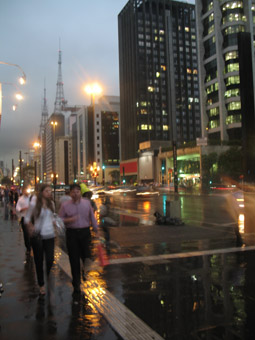
Av Paulista, Sao Paulo
photo Carlos Gomes
Av Paulista, Sao Paulo
ze celso
Silvana Garcia is a lecturer and writer from EAD (Escola de Arte Dramatica), a drama school linked with the University of Sao Paulo (USP). She talked firstly about the importance of Ze Celso, the iconic, militant, anarchic director who has worked continuously in theatre since the 1960s. His Teatro Oficina is a building with a 30-metre-long, narrow-corridor performance space, above which are suspended three levels of scaffolding. From these vantage points audiences witness his anthropophagic, durational performances. Ze Celso’s work dives into social taboos, challenging the puritanical aspects of Brazilian society. For example, what appears to be a religious procession (common throughout predominantly Catholic Brazil) is subverted, and transformed into an assemblage of Dionysian profanities. Sex acts and nudity are emblematic of his shows. His performances launch from the theatre into the streets, stopping the traffic. Prostitutes, homosexuals and black Brazilians (still fringe-dwellers of Brazilian society) are Ze’s heroes. Ze Celso invites his audience not only to observe, but also to participate in his celebrations of the social taboos that can oppress and shame.
Anthropophagy is a fundamental concept in Ze Celso’s work. He borrows this term from the Brazilian modernist writer Oswald de Andrade. It refers to the act of humans devouring their own flesh, as witnessed by the Portuguese colonisers amongst Brazilian Indian tribes. In cultural terms anthropophagy refers to the digestion of the Other in the phenomenology of cultural encounters. If de Andrade sees anthropophagy as the ultimate taboo, the work of Ze Celso employs this “taboo of taboos” as a departure point for his work, transforming taboo into totem. Itau Cultural’s exhibition explores some of the artistic voyages and manifestos of Ze Celso’s extensive career. The online exhibition captures aspects of Ze Celso’s vision and philosophy. Its English version will allow you a glimpse into the life and times of the artist (www.itaucultural.org.br/ocupacao/).
sesc
Silvana then spoke about how this city hosts the most diverse range of artists. From the mid-1990s, changes in the Brazilian government’s cultural policies allowed for greater financial incentives to support cultural activities. Existing organisations such as SESC (Serviço Social do Comercio) also support cultural activities and development. SESC, for example, is a non-government cultural network established in 1946 by the industrial sector of the state of Sao Paulo and other states in Brazil that is supported through tax incentives and employee contributions. SESC is committed to providing services in the areas of health, leisure, culture and social support to populations throughout Brazil. SESC has established a number of cultural sites in Sao Paulo (housing theatres, music venues, libraries, artist studios, galleries etc) that run an extensive program of events every day of the week. These are open to the public and provide discounted tickets for employees of the industrial sector (www.sescsp.org.br).
Danilo Miranda has been the head of the performance department for SESC for the past decade and strongly supports young, emerging groups researching and creating works that interface with the wider Brazilian cultural landscape. SESC also has sufficient resources to invite and host international companies and works. It will buy new work from concept stage and support its development, or will invite an existing work to be presented for an extended seasons, touring through its network of cultural centres in Sao Paulo and throughout Brazil. For many companies SESC provides critical support in both creating and touring work, opening new possibilities for artistic development that would not otherwise be available to them.
Silvana gave me a few names and contacts for companies and venues that would assist my investigations, including Teatro da Vertigem, Grupo XIX, Grupo dos Fofos, writer Mario Bortolotto, Galeria Vermelho, Satyros, Newton Moreno and numerous others. As my time was limited in Sao Paulo, I’ve selected just a few of these companies to introduce to you.
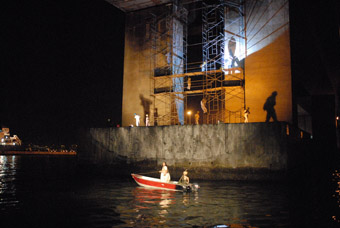
Marilia De Santis, Sergio Pardal, BR3, Vertigen
photo Nelson Kao
Marilia De Santis, Sergio Pardal, BR3, Vertigen
teatro da vertigem: making the city their stage
Teatro da Vertigem is a collective of performer-creators established in 1991 and led by Antonio de Araujo, who also lectures at ECA (Escola de Comunicacoes e Arts) at the University of Sao Paulo. Initially self-funded, the company now receives some financial support from Petrobras, a Brazilian oil company.
I met with members of company in the eighth floor of SESC Paulista, where they were bumping in a new work, Kastelo. From what I can see of the new show, the audience will sit on office chairs around the inner space of the building and the performance will take place on a platform rigged outside the glass walls of the building. What a logistical nightmare! I met with performer Roberto Audio and director Eliana Monteiro to talk about the group. Their work involves an extensive process of research and is mostly presented in non-conventional theatre sites around Sao Paulo. Vertigem’s work exists on the frontier between performance and contemporary theatre.
The group’s most important work, known as the Biblical Trilogy, is a criticism of the social and political degradation of the country. Paraiso Perdido (1992) was performed in a Catholic church, O Livro de Jo (1995) in a hospital and Apocalipse 1.11 (1999) in gaols (referencing Carandiru prison where 111 prisoners were killed by police in a prison rebellion). This trilogy has been presented at national and international festivals.
Talking about logistical nightmares, Vertigem’s latest work BR-3 was performed along five kilometres of the Tiete River that runs through the middle of Sao Paulo. The audience was taken by bus from the Monument to Latin America Complex (a concrete modernist design) to a dark bend in the Tiete River. From this we are invited to board a boat, a kind of floating evangelical church with a neon sign proclaiming, “Jesus is whiter than snow.” On board, the audience is promised salvation by the recorded voice of a dead evangelical minister, the proceedings being conducted by a devoted disciple. The sounds of recorded gunshots mix with the buzz of traffic on the highway beside the river. The dark river and the glittering cityscape beyond its banks are the backdrop for the show. The Tiete is one the most polluted rivers in Brazil—the smell is overwhelming, the pollution a sad reality, the result of rapid, unplanned urbanisation. But there is no way out, and the church boat is our only salvation!
The performance is located in three cities of Brazil, in three different periods: Brasileia, a lost city in Acre near the Amazon River; Brasilandia, a poor suburban area of Sao Paulo where drug trafficking is rife; and Brasilia, the planned, ordered and monumental Brazilian capital. Along the margins of the river, for example, we witness a woman searching for her lost husband, whose cheap labour has been used to build monumental cities like Brasilia.
Vertigem’s BR-3 is created using performers on the principal boat, projections onto passing bridges, small fast boats that circle the main craft and performers with microphones working on the margins of the river. It is a quite confronting, apocalyptic experience witnessing such human desperation. One of the great things about Vertigem is their ability to merge the world of fiction with the real world, leaving us wondering which is which.
After nearly 20 years, Teatro da Vertigem now have their own rehearsal space where they continue to research new works and conduct workshops for each new production. Vertigem also work with local communities, inviting members to participate in their performances. (www.teatrodavertigem.com.br)
artist occupation: transforming the city
Praça Roosevelt (Roosevelt Square), in the centre of Sao Paulo, was in former times a glamorous part of the city, but is now a dark and sometimes dangerous part of town. It was also once the home and workplace of socially neglected individuals, prostitutes, transvestites and rent boys but is now undergoing a process of reformation.
Through necessity (cheap real estate), independent theatre companies have recently moved into Praca Roosevelt, establishing small, versatile theatre spaces that allow artists great freedom in terms of experimentation and artistic risk-taking. The larger established theatres are too expensive for smaller and emerging theatre companies.
Satyros is one such company, and was among the first to establish a theatre space in Praca Roosevelt approximately 10 years ago. Led by dramaturg Rodolfo Garcia and actor Ivam Cabral, the group has become one of the most controversial in Brazil. In many instances their work, like that of Ze Celso, reflects the universe of sexual and social minorities, and the marginal world of the site in which they are based. Their works have included Sappho de Lesbos (by Ivam Cabral and Patricia Aguille), Filosofia de Ancova (devised from the works of the Marquis de Sade) and Transex, performed by Phedra D Cordoba (a transsexual who formerly lived at Praca Roosevelt and who has become an important artistic collaborator with the company).
In 2005 the company presented German writer Dea Loher’s A Vida na Praca Roosevelt (based on the inhabitants of the square). It was awarded the prestigious Beckett prize in Germany. The company has shown its work in major festivals in Brazil, and throughout Latin America and Europe.
Now the Square has eight new venues (theatre spaces complete with bars and cafes) that present many diverse styles of performances, becoming a vibrant part of the cultural landscape of Sao Paulo.
There is currently a redevelopment project underway, supported by the government of Sao Paulo, to renovate the square and to build a school of performing arts on the site for about 1000 students a year.
Historically Praca Roosevelt has received very little support from the politicians, other artists and the media (some journalists refused to attend the performances). A decade later, the artists who ‘occupied’ Praca Roosevelt and who believed in their artistic utopia feel that they have conquered both the Praca itself, and won the respect of their peers, politicians, the media and society at large. The persistence, creativity and hard work of these artists have inspired other small companies to initiate their own ‘occupations’ in other parts of the city.
Cracolandia (so called for the prevalence of the drug crack) in the old historical part of Sao Paulo is also undergoing an arts-led transformation. Work will shortly commence on the construction of a centre that will become the home of the contemporary dance scene in Sao Paulo. Swiss architects Jacques Herzog and Pierre de Meuron, known for their bird nest Olympic Stadium in Beijing and the Tate Modern in London, will design the building.
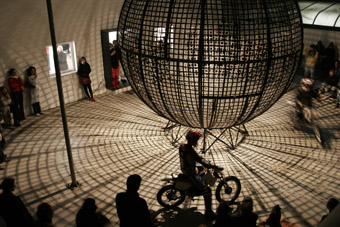
Christiana Moraes, Andre Nunes, Globo da Morte, VERBO
courtesy Galeria Vermelho
Christiana Moraes, Andre Nunes, Globo da Morte, VERBO
verbo international performance festival
At the end of Avenida Paulista is Galeria Vermelho, a commercial gallery that represents a number of important Brazilian contemporary artists. The building itself has grown into a series of rooms, corridors and courtyards that, for a week in June, hosts a number of live performance works from local and international artists in a festival called VERBO, is one of the most important performance events in Brazil’s arts calendar.
VERBO is now in its sixth year. One of its curators, Marcos Gallon, explained that it sprang from the need of young and emerging artists to have a space where their work and concepts could meet the public. The director of the gallery, Eduardo Brandao, together with a number of curators selects the works. Marcos described how, during the early days of VERBO, they tried to accommodate the demands of all the performing artists wanting to be part of the festival so that hundreds of “action” performances would take place during the festival. Now the director and curators select just 50 events for gallery space and in public spaces in the city.
VERBO takes place in June and is open to any artist who submits an artistic proposition. There are also a number of seminars, workshops and publication launches presented with the support of FUNARTE (Fundaçao Nacional das Artes) and Centro Cultural Sao Paulo, two major arts organisations in Brazil. Applications to the festival are made via www.galeriavermelho.com.br. An English version of the application process can also be found on the website as Galeria Vermelho is very interested in Australian performance. The versatility of the space can host a diverse range of work.
Performance in Brazil originates largely from the 1970s and has been influenced to a large extent by European ideas and concepts. The body is the main performance subject as are ideas around it such as informatics, bioethics, the body as a weapon etc. A new generation of performance artists in Sao Paulo is creating work that explores the quotidian body, the socio-political realm and urban street culture in response to their city. PUC (Pontifical Catholic University) and Faculdade de Belas Artes have specific courses on Performance and the Art of the Body. The major universities and the visual arts department are creating generations of artists who are expanding the ideas of performance art by fusing new media, dance and voice.
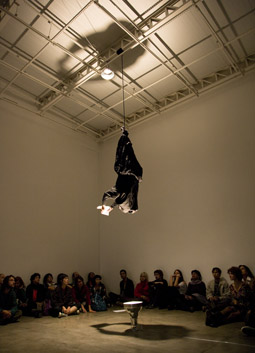
Nezaket Ekici, VERBO 2009
courtesy Galeria Vermelho
Nezaket Ekici, VERBO 2009
Marcos described some of the performances that have been part of VERBO, to give an idea of how Galeria Vermelho comes to life in a week of contemporary performance. Turkish artist Nezaket Ekici dressed in a burka is rigged upside-down from the ceiling, reading, then dropping to the floor, newspaper articles about the injustices and violence suffered by Islamic women. Outside in the courtyard a truck arrives, full of concrete bricks. Artists Caroline Mendonca and Bruno Freire construct, deconstruct and re-construct a 20 metre wall, transforming and redefining and reconfiguring the public space of the gallery. Los Torreznos, a collective from Spain, have a more direct interaction with the public, creating political and social discussions, improvising vocally on the themes of El Cultura and El Dinero, making a humorous critique of this territorium.
In a white gallery Marco Paulo Rolla (an important Brazilian performer) creates Suando e Resistindo (Sweating and Resisting), a compelling and risky performance where three performers create a choir of voices interspersed with the sound of breaking house objects. Nancy Mauro-Flude (Australia/Holland) performs Paraphernalia, a karaoke cabaret performance with break beats, noisy guitars, pop, punk rock influences with a trash aesthetic.
Les Gens D’Uterpan (France) is a dance collective that constructs its choreographies in different parts of the space, contrasting harsh and violent acts where their bodies are in intense collisions with serene dances where the dancers dribble saliva over each other as they move smoothly through the space. A big metal sphere is built to the sounds of two revving motorbikes in Globo da Morte (Death Globe), creating great expectation. The sphere is completed,but the act remains unconsummated. The sphere is dismounted, frustrating an audience that asks, ‘Where is the spectacle?’
* * * *
Sydney and Sao Paulo share similarities but there are also vast differences in their respective cultural practices. What can they learn from each other? I am excited by the idea that maybe one day they will establish a dialogue that explores their respective artistic natures. For example, Verbo’s presentation of hybrid arts practices and its focus the performative body make it a relevant point of contact for Sydney artists who share similar preoccupations. What cultural specificity can be discerned in Verbo’s representation of the body? Perhaps a Sydney institution will one day host a Verbo festival. Links between venues in Australia and SESC could create a network of cultural exchange allowing for the introduction of Australian artists to Brazil, and vice versa. I see great possibilities in small independent performance companies in Sydney and Sao Paulo leading the exchange.
RealTime issue #95 Feb-March 2010 pg. 42-43






